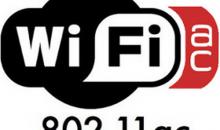802.11ad, also called WiGig 1.0, is a proposed specification in the 802.11 family applicable to WLANs (wireless local area networks). 802.11ad represents an extension or update of the current 802.11a standard.
Networks using 802.11ad will operate in the 60-GHz(gigahertz) band using OFDM (orthogonal frequency-division multiplexing). The enhancements supported by 802.11ad will facilitate simultaneous streaming of HD (high definition) video to multiple clients in large office environments, as well as faster wireless synchronization and backup of large files.
New features that will exist in 802.11ad, over and above those proposed for 802.11ac (another enhancement to 802.11a), include:
* Native 802.11a/b/g/n/ac support.
* Seamless switching between 2.4-, 5-, and 60-GHz bands.
* Channel width up to 2160 MHz (megahertz).
* Throughput of up to 7 Gbps (gigabits per second).
* Built-in support for wired connections.
* Working range of 10 meters or more.
* Improved functionality for mobile devices.
* Advanced security features.
* Support for power management.
-Future” WiFi Technologies
802.11AH
802.11ah is 900 megahertz WiFi, which is ideal for low power consumption and long-range data transmission. It’s earned the nickname “the low power WiFi” for that very reason.
Who will use it: Companies who have sensor-level technology that they need to be WiFi-enabled.
Benefits:
* Can penetrate through walls and obstructions better than high frequency networks like 802.11ad, which we’ll discuss below.
* Great for short, bursty data that doesn’t use a good deal of power consumption and needs to travel long distances. This would be applicable in smart building applications, like smart lighting, smart HVAC, and smart security systems. It would also work for smart city applications, like parking garages and parking meters.
Downfalls:
* There is no global standard for 900 MHz. Right now, 80% of the world uses 2.4 GHz WiFi. That is a benefit because you can connect on these global standard bands anywhere in the world. (If you’re on a Mac, try this: hold down the option key and click your WiFi symbol at the top. You’ll see a bunch of information about the WiFi network you’re connected to, including channel.)
* AH isn’t available right now. The IEEE is in the final phases of resolving the standard, and once that’s done—currently slated for March 2016—the chip manufacturers (like HUAWEI, Broadcom, and Qualcomm) will have a chance to start creating physical layer chips. You will most likely start seeing WiFi AH products appear in the next 18 months to two years. The good news, however, is that organizations are providing similar technology for low power, wide-area networks (LPWAN) now, so you don’t have to wait until 802.11ah is complete to benefit from the technology.
802.11.AF
802.11af utilizes unused television spectrum frequencies (i.e., white spaces) to transmit information. Because of this, it’s earned the nickname “White-Fi.” Because these frequencies are between 54 MHz and 790 MHz, AF can be used for low power, wide-area range, like AH.
Who will use it:
* Organizations that need extremely long-range wireless networks.
* Lower interference can drastically improve performance.
Benefits:
* Because AF can use several unused TV channels at once, it can be used for very long range devices—potentially up to several miles, with high data rates.
Downfalls:
* It’s still in proposal stages, so it hasn’t been approved or released to the mass market yet.
* “White space” channels are not available everywhere, like in big cities.
Conclusion
802.11ah (low data rate, long-range sensors and controller WiFi), 802.11af (or “White-Fi, as it uses unused TV spectrums for long-range transmission), and 802.11ad (the non-wired multigigabit high-performance networking WiFi) are three important up-and-coming changes to WiFi as we know it.
These three amendments are clear evidence that WiFi has undergone a spectacular transformation in the past decade and a half. And with the IEEE reviewing amendments to the 802.11 protocol on a near regular basis, we’re certain that the next 15 years will hold just as many interesting changes.
Graphic courtesy of Microwaves & RF
Article subject by linklabs,
modified by najib Khalaf

